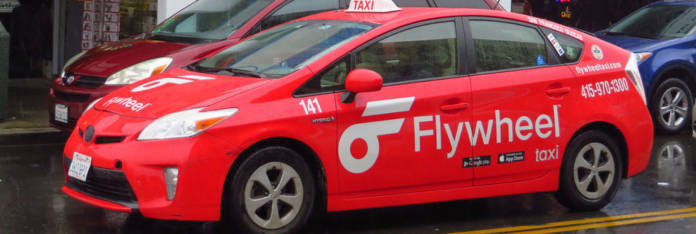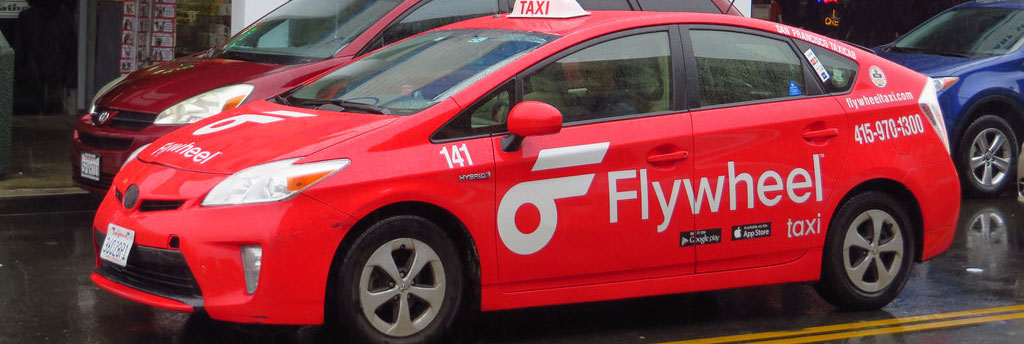
“I can’t even afford to go to work,” said taxi driver Colin Marcoux, who has been driving a cab for over two decades.
COVID has caused a sharp decline in taxi ridership, as people comply with the city’s shelter-in-place order, which was extended until May 3. Because of the lack of customers, many taxi drivers have parked their cabs rather than continue working. Kelly Dessaint, a cab driver and SF Examiner columnist, told me why many drivers are deciding to stop driving.

“People are making ten bucks a day… I bet the [Yellow Cab parking] lot is a sea of yellow…when I was working it was all personal cars,” said Dessaint.
Hansu Kim, owner of Flywheel Taxi, estimates that only about one-third of the 1,410 cabs in San Francisco are still currently active. Muwaffaq Mustafa, the operations manager of Flywheel Taxi, told me that Flywheel and its partnering cab companies have 550 taxis in their fleet, and currently only 125 are on the road. Calls for cabs have dropped 85 percent since shelter in place, according to Mustafa.
“Every day that goes by there’s less and less business,” said Mustafa.
I reached out to the San Francisco Municipal Transportation Agency, which regulates the taxi industry in San Francisco, and was told that they do not record taxi dispatch data. Kim also confirmed this to be true.
Even before the coronavirus, the taxi industry had faced tough competition from Uber and Lyft. Now, with ridership extremely low due to the pandemic, drivers are worried that this will be the final nail in the coffin. Kim is worried that Flywheel Taxi may fail because of the pandemic.
“With this shutdown, it’s about our business surviving. Two thirds of of my cabs are parked,” said Kim.
Help us save local journalism!
Every tax-deductible donation helps us grow to cover the issues that mean the most to our community. Become a 48 Hills Hero and support the only daily progressive news source in the Bay Area.
What makes this a problem is the essential role that taxis play in the paratransit services in San Francisco.
Since the passage of Proposition E in 1999, the SFMTA has regulated cab companies in San Francisco, and since then has incorporated taxis into its fleet of paratransit vehicles, which offer discounted rides for seniors and disabled people.
During the COVID pandemic, taxis have been essential in helping the elderly and disabled people go to the hospital and other essential travel.
“I spend half my day taking elderly and disabled people to the grocery store,”said Marcoux.
The SFMTA has also stated that taxis are essential to SF’s paratransit system. A statement from the SFMTA’s spokesperson, Erica Kato said “taxis have been an integral part of Paratransit since the early 1980s and San Francisco has had wheelchair accessible ramp taxi service since the early 1990s. We are proud that taxis continue to deliver these critical services to our most vulnerable citizens during these challenging times.”
While taxi drivers have the option to park their cabs, many feel that they cannot given their imperative role in the paratransit system.
“The guy I’m driving around is in his seventies. What am I supposed to do, just let him die?” said Sutter. His passenger chimed in as well, “We’re panicking,” he said.
Sutter and other taxi drivers, he explained, are dedicated to helping the elderly, and given how often their passengers are elderly and disabled, many feel that if they don’t work, they will leave these vulnerable people behind, a prospect made especially dangerous by the coronavirus.
Although many cab drivers are dedicated to helping vulnerable populations during the pandemic, many are concerned for the health of themselves and their households, as their job requires them to be in close proximity to strangers. Several of the drivers I spoke to mentioned that they are not provided personal protective equipment.
“The city should provide all frontline workers with PPE,” said Brent Johnson, another taxi driver. “I have a friend who is a firefighter and we compare notes every day. We’re alarmed that not every frontline person has PPE.”
Taxi drivers, who want to continue serving those who need paratransit services for essential travel, also feel conflicted because their lack of protection makes them possible vectors for the coronavirus, infecting the very population they are trying to serve.
“I had a flag the other day around Post and Fillmore, it was an 82-year-old woman who was getting groceries, and I was terrified for her. I was glad she was in my cab because I wipe things down good,” said Johnson.
In anticipation of this risk many cab companies, including Yellow Cab, are advertising their cabs as “sanitized,” meaning that the taxi is regularly cleaned and frequently-touched areas of the cars, such as door handles, are cleaned with sanitizing wipes.
But paratransit rides alone are not enough to sustain cab drivers right now. To try and make ends meet, many taxi drivers are now doing food delivery for apps like Caviar and Doordash, although it’s still not enough.
“It’s the only way that I am making any money. I’m delivering for Caviar and Doordash, and barely making enough to survive,” said Sutter. Johnson told me that because food delivery apps like Caviar are only busy between 4 and 9pm, there just isn’t enough work to make the amount of money they need.
Cab drivers will be relying on federal assistance to get by, but there are some concerns around how they will file for unemployment. The CARE Act,a $2.2 trillion relief measure which was passed on March 23 by Congress, extends unemployment insurance to sole proprietors and independent contractors, but when I reached out to the Employment Development Department of the State of California, they replied saying that California has yet to amend their code around unemployment insurance to comply with the measure. As a result, independent contractors and sole proprietors are still largely exempt from receiving coverage, including the additional $600 on top of regular unemployment benefits and the 13 week extension of benefits paid for by the federal government when someone exhausts their regular UI claim:
The EDD has reviewed the federal CARES Act and is working on programing needed to implement the new provisions for the unemployed but, like all other states, we are still awaiting further guidance from US Department of Labor (DOL) to complete that programming… EDD is working quickly with state partners to serve unemployed Californians who don’t usually qualify for regular state unemployment benefits, including the self-employed.
The EDD is also uncertain about how they will accept income reports from independent contractors who are not issued W2 forms and are largely paid in cash, which includes taxi drivers.
When taxi drivers, who are technically self-employed, do apply for unemployment insurance, they can put their own name as their former employer and immediate supervisor in their claim.
One available option for taxi drivers to receive financial relief, according to with Matthew Daus, partner and chair of the Windels Marx Transportation Practice Group at New York-based law firm Windels, Marx, Lane & Mittendorf, is to file for a small business loan under the Payroll Protection Program established by the CARE Act. The principal on the loan can be forgiven if used for business operating costs and will be the equivalent of roughly two and a half months of the business’ income, with interest rates fixed at 0.5 percent. Eligible costs would include car payments like gas, tires, other maintenance, and the interest on medallion loans, according to Jeannie Occhiogrosso, an attorney at Windels, Marx, Lane & Mittendorf.
When filing your application, you will need to provide proof of income, either in the form of bank statements or tax documents, according toOcchiogrosso. Whether you’ll need to bring a bank statement or tax documents will depend on your bank or credit union wants, so you’ll need to call them to find out. Occhiogrosso assured me that lenders will likely be flexible in terms of what income statements they will accept when qualifying borrowers.
“The lenders won’t be crazy,” said Occhiogrosso.
Occhiogrosso encourages those seeking a small business loan to apply as soon as possible, because the CARE Act caps the amount of money available for loans at $349 billion.
“There might not be enough money left to get two and a half months’ income if you applied in May,” said Occhiogrosso.
You can fill out the application here. If you’re a borrower, and what more information on the PPP forgivable loan program, you read more about it here. Contact your bank or credit union to find out more about what documentation they will need to determine your eligibility for a covered loan.
Banks and credit unions interested in becoming a federally authorized lender of PPP loans can determine their eligibility and learn more here.

